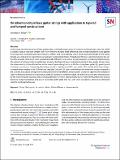Files in this item
On inharmonicity in bass guitar strings with application to tapered and lumped constructions
Item metadata
| dc.contributor.author | Kemp, Jonathan A. | |
| dc.date.accessioned | 2020-03-18T11:30:03Z | |
| dc.date.available | 2020-03-18T11:30:03Z | |
| dc.date.issued | 2020-03-13 | |
| dc.identifier | 266739834 | |
| dc.identifier | ff2bea19-b781-474d-8c0a-3ac7b350aa97 | |
| dc.identifier | 000532826500124 | |
| dc.identifier | 85100801093 | |
| dc.identifier.citation | Kemp , J A 2020 , ' On inharmonicity in bass guitar strings with application to tapered and lumped constructions ' , SN Applied Sciences , vol. 2 , 636 . https://doi.org/10.1007/s42452-020-2391-2 | en |
| dc.identifier.issn | 2523-3971 | |
| dc.identifier.other | ORCID: /0000-0002-3861-4863/work/70919996 | |
| dc.identifier.uri | https://hdl.handle.net/10023/19673 | |
| dc.description.abstract | In this study, the inharmonicity of bass guitar strings with and without areas of lowered and raised mass near the saddle is studied. Using a very high sample rate of over 900 kHz enabled finite difference time domain simulation to be applied for strings that simultaneously have nonzero stiffness and linear density which varies along the length of the string. Results are compared to experiments on specially constructed strings. Perturbation theory is demonstrated to be sufficiently accurate (and much more computationally efficient) for practical design purposes in reducing inharmonicity. The subject of inharmonicity is well known in pianos but has not been studied extensively in bass guitar strings. Here, the inharmonicity is found to be low in the lowest (open string) pitch on the five string bass guitar (B0) given typical standard construction. Conversely, the inharmonicity is high (around 100 cents at the 10th partial) when that string is sounded when stopped at the 12th fret and very high (around 100 cents at the 6th partial) when that string is stopped at the 21st fret. Bass guitar strings were constructed with three different constructions (standard, tapered and lumped) in order to demonstrate how incorporating a lump of raised mass near the saddle can achieve close to zero inharmonicity for the lower frequency partials. This also has potential in terms of improving the use of higher fret numbers for musical harmony (reducing beating) and also in controlling pitch glide that has, with some exceptions, often been attributed solely to nonlinear behaviour. | |
| dc.format.extent | 13 | |
| dc.format.extent | 1424356 | |
| dc.language.iso | eng | |
| dc.relation.ispartof | SN Applied Sciences | en |
| dc.subject | String | en |
| dc.subject | Bass guitar | en |
| dc.subject | Acoustics | en |
| dc.subject | Music | en |
| dc.subject | Finite difference | en |
| dc.subject | Inharmonicity | en |
| dc.subject | M Music | en |
| dc.subject.lcc | M1 | en |
| dc.title | On inharmonicity in bass guitar strings with application to tapered and lumped constructions | en |
| dc.type | Journal article | en |
| dc.contributor.institution | University of St Andrews. Music Centre | en |
| dc.identifier.doi | 10.1007/s42452-020-2391-2 | |
| dc.description.status | Peer reviewed | en |
This item appears in the following Collection(s)
Items in the St Andrews Research Repository are protected by copyright, with all rights reserved, unless otherwise indicated.

